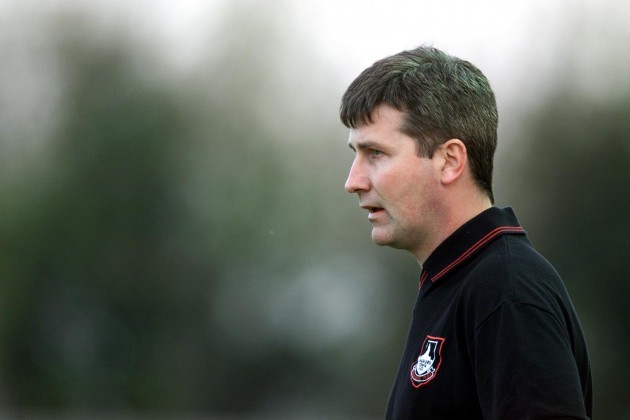THERE IS ART to be found in everything: even a midweek League Cup game between Longford Town and Home Farm at an almost entirely-empty Whitehall.
It was in that game 20 years ago Adrian Duncan earned his one and only first-team appearance for his home-town club, brought on as a half-time substitute in a 3-1 defeat.
“That was the high point of my career. Two-thirds of the way through the second half, I got the ball and passed it back to the right back”, Adrian tells this week’s episode of Behind the Lines.
- To get access to the archive of more than 70 BTL episodes – featuring Wright Thompson, David Walsh, Diane K Shah, Michael Foley and many more — join The42 here
“I turned and the right back hit this lovely cultured pass and the other midfielder Peader Malone, who flicked it on and it span out in front of me. I ran on to it but I remember my legs were clipped and I knew I should have gone down. I kept on my feet and slid towards the endline, and crossed the ball. I remember Shay Zeller headed the ball, it was handled on the line, we got a penalty which we scored and lost 3-1.”
It was, he says, “completely unimportant”, but years later became the final scene of Duncan’s short story “Prosinečki”, which was first published by Sally Rooney at Stinging Fly and is now part of his fabulous collection of short stories, Midfield Dynamo. (The stories are arranged in a 1-4-4-2 formation in the book, with the story on the margins under the title ‘Coach’ the only one not told in the first person.)
“The ball slows into its languid arc”, concludes the story, “and as his body coils and his eyes wince shut, bringing him to the great pre-impact dark that every footballer knows, I gasp, once more, at the impotent, incidental, and unforgivable beauty of it all.”
It’s not only the incidents of that game that have travelled well: so has another of its personalities. The manager who gave Duncan his debut was one Stephen Kenny.
“Because I was living in Dublin, Stephen Kenny said, ‘Come out and you can train with us in Dublin.’ When I say Dublin, it was Celbridge, and when I say training pitch, it was a patchily-lit, extremely muddy square of grass at the bottom of a driving range. There were two little spotlights on it, it was rough, you could barely see, and every now and again a golf ball would plop down beside you.
“Because the training conditions were so bobbly and muddy and so poorly-lit, that at weekends when they went onto a pitch, they were playing superb football. Really direct and fast and full of goals.
“It is funny, there was a feeling among people even then that this guy [Stephen Kenny] was going to go on and do something really, really interesting and special in the game if things went well for him.
“He is an extremely nice man, first of all, and the players wanted to do well for him. They would run through walls for him. Before a game he would come in and would always say something slightly disarming. He’d say something like, ‘Ye all look great lads.’ Something like that, something aesthetic that wasn’t, ‘Go out and hammer this lot.’
From the few contacts I had with him when I was with the reserves, he would take you aside every now and again and he just knew what to say to you. He seemed to me to have a very strong reading of people, and of how to communicate with them.Really good managers know how to man-manage, and in recent years it has become recognised that the better you can man-manage the more successful you’ll be. He definitely had that, even though I didn’t know that was happening at the time, it’s only now looking back at it.”
Those ideas of aesthetics in football greatly interest Duncan, and they are the subject of the revelation in “Prosinečki”, in which the narrator – a midfielder in the twilight of his career – learns that the titular midfielder’s audacious range of passing were largely acts of efficiency to help his team win games, rather than gratuitous acts of flair.
“It is the pragmatic that serves the aesthetic” concludes the narrator.
“Aesthetics in footbal really interests me, this sense of ‘who is football for?’”, says Duncan. “When you’re playing, are you hitting a pass because it’s effective or because it’s beautiful and will get the crowd on its feet?
“I look at Roy Keane’s passing in his pomp, and none of it is necessarily beautiful. It’s more like a boxer jabbing: a really effective jab, this ball that keeps on cutting through two and three people and into feet on the turn. Keane must go down as one of the most effective passers in the UK game in the last 20 years.
“In terms of a highlights reel you’ll almost never see one of his passes on it, that’s always more of a Steven Gerrard thing. I have an opinion my friends find controversial, that Gerrard wasn’t all that great a player as he too often showed the less effective but more handsome passes. To liken him to Scholes and Keane is like apples and oranges; it’s the wrong analogy.
“I think that’s one of the reasons Liverpool never won a league with Gerrard. He didn’t have that kind of psychotic jabbing that was required by the United midfielders, who said, ‘We don’t really care how this looks, we just want to pass three players and break those lines. And if you break lines over 90 minutes you will score goals.
“That relationship between pragmatism and aesthetics on the pitch is always happening and I find it really interesting.”
There is no football aesthetic now more intrusive than VAR, which Duncan hates.
“I think it’s a terrible step as it suggests football should be fair and should somehow be accountable to other people. I don’t think it should be. it should be unfair because it’s a game of human beings and the referee is in that flux, interpreting and enacting rules.
“The players are trying to fool the referee and others are trying to play fairly, it’s all part of it. And of course there are errors, it’s a game.
“And I think grievance is a really important part of football. The one that binds every Irish fan of our generation is Thierry Henry’s handball. We will never forget it, it’s a grievance that will be talked about for another 20 years and that is something that connects generations of supporters. I think that is more important than stopping, killing, auditing and reviewing a game, and after some sort of corporate audit the whole thing is okayed to proceed.
“It’s a horrible step in the aesthetics of the game. Some people say it’s teething problems but it’s not: it’s the idea of it. The idea that suddenly unfairness is not acceptable….what a crazy, crazy thought.”
You can listen to the full interview by subscribing at members.the42.ie.


